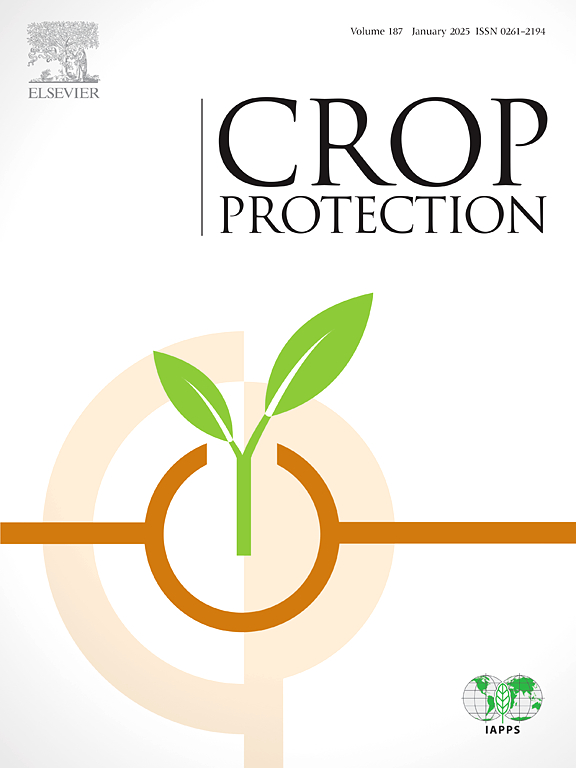Baseline susceptibility and biochemical mechanism of field-evolved resistance in brown planthopper, Nilaparvata lugens (Stål) to flupyrimin in India
IF 2.5
2区 农林科学
Q1 AGRONOMY
引用次数: 0
Abstract
The brown planthopper, Nilaparvata lugens (Stål), is one of the most devastating and economically significant rice pests in Asia. Widespread application of chemical insecticides for controlling brown planthopper (BPH) has resulted in resistance to several insecticides leading to frequent control failures in the field. The newly introduced pyridylidene insecticide flupyrimin provided a novel tool to control BPH because of its unique target site and high selectivity. The present study examined the relative susceptibility of twenty-nine field populations of N. lugens to flupyrimin where most BPH strains exhibited negligible resistance levels (resistance ratio between 1.15 and 8.23-fold) compared to the Lab/Nlgn-WB strain. However, the field strain collected from Chhattisgarh (Rp-CG) showed moderate resistance to flupyrimin (48.63-fold). Following laboratory selection, a significant cross-resistance to clothianidin (26.18-fold) was observed in the flupyrimin-resistant (FPM-R) strain of BPH with a lack of cross-resistance to sulfoxaflor, triflumezopyrim, buprofezin, pymetrozine, and other tested neonicotinoids. Piperonyl butoxide (PBO) significantly synergized the activity of flupyrimin (2.74-fold) in the FPM-R strain of N. lugens. Compared to the FPM-S strain, the P450 enzyme activity of the FPM-R strain of BPH was increased significantly (3.09-fold), and five P450 genes were overexpressed at mRNA level to >2.0-fold in the later strain. Besides, the knockdown of the highest upregulated (21.69-fold) CYP6AY1 gene by RNA interference (RNAi) remarkably increased the flupyrimin toxicity against BPH. The present results suggested that metabolic detoxification by the overexpression of CYP6AY1 could play a significant role in the resistance of N. lugens to flupyrimin. These findings will aid in formulating effective strategies for insecticide resistance management, contributing to the sustainable control of BPH in the field.

求助全文
约1分钟内获得全文
求助全文
来源期刊

Crop Protection
农林科学-农艺学
CiteScore
6.10
自引率
3.60%
发文量
200
审稿时长
29 days
期刊介绍:
The Editors of Crop Protection especially welcome papers describing an interdisciplinary approach showing how different control strategies can be integrated into practical pest management programs, covering high and low input agricultural systems worldwide. Crop Protection particularly emphasizes the practical aspects of control in the field and for protected crops, and includes work which may lead in the near future to more effective control. The journal does not duplicate the many existing excellent biological science journals, which deal mainly with the more fundamental aspects of plant pathology, applied zoology and weed science. Crop Protection covers all practical aspects of pest, disease and weed control, including the following topics:
-Abiotic damage-
Agronomic control methods-
Assessment of pest and disease damage-
Molecular methods for the detection and assessment of pests and diseases-
Biological control-
Biorational pesticides-
Control of animal pests of world crops-
Control of diseases of crop plants caused by microorganisms-
Control of weeds and integrated management-
Economic considerations-
Effects of plant growth regulators-
Environmental benefits of reduced pesticide use-
Environmental effects of pesticides-
Epidemiology of pests and diseases in relation to control-
GM Crops, and genetic engineering applications-
Importance and control of postharvest crop losses-
Integrated control-
Interrelationships and compatibility among different control strategies-
Invasive species as they relate to implications for crop protection-
Pesticide application methods-
Pest management-
Phytobiomes for pest and disease control-
Resistance management-
Sampling and monitoring schemes for diseases, nematodes, pests and weeds.
 求助内容:
求助内容: 应助结果提醒方式:
应助结果提醒方式:


